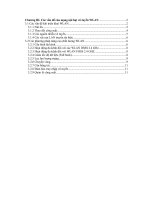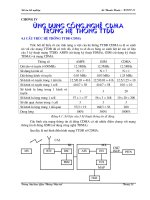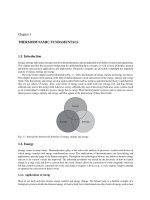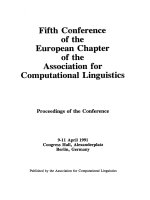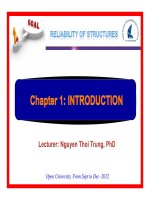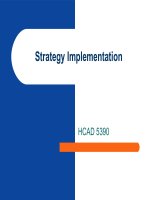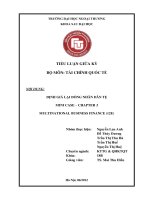Khoa2022 chapter theaccommodationservicesbookin
Bạn đang xem bản rút gọn của tài liệu. Xem và tải ngay bản đầy đủ của tài liệu tại đây (433.42 KB, 16 trang )
The Accommodation Services Booking Intention
Through the Mobile Applications of Generation
Y: An Empirical Evidence Based
on TAM2 Model
Bui Thanh Khoa1(B) , Nguyen Minh Ha2 , and Bui Hoang Ngoc2
1
2
Industrial University of Ho Chi Minh City, 12 Nguyen Van Bao, Ward 4,
Go Vap District, Ho Chi Minh City, Vietnam
Finance, Economics and Management Research Group, Ho Chi Minh City Open University,
35-37 Ho Hao Hon Street, District 1, Ho Chi Minh City, Vietnam
{ha.nm,ngoc.bh}@ou.edu.vn
Abstract. Applying information technology to business activities is one of the
core competencies to create a competitive advantage for modern businesses.
Competition among hospitality businesses is fierce, requiring businesses to take
advantage of every advantage and opportunity to acquire customers, one of the
ways to achieve that goal is to use the mobile applications for customers booking online accommodation services. The study’s objective is to experiment with
the accommodation services booking intention through the mobile applications
of generation Y, born from 1981 to 1996, based on the Technology Acceptance
Model 2 (TAM2). The mixed study method is used to archive the research objective. The results show that all relationships in the model are supported. Research
results were the basis for proposing the managerial implication for businesses.
Keywords: TAM2 · Accommodation services · Generation Y · Mobile
applications
1 Introduction
The tourism and hospitality industry are achieving inevitable success in the current
period around the world (Kamboj and Rahman 2017). Active exploitation of this
“smoke-free industry” is considered the top task set out in each country’s socioeconomic development policy. Infrastructure investments are increasing every year,
such as road improvements, transportation improvements, tourist attractions, and scenic
spots. Besides, the government’s investment and the private sector in accommodation
services to serve tourists are strictly required to develop tourism activities in the locality. In addition to building new accommodation establishments, renovating old ones,
upgrading service quality, computerizing the accommodation booking process through
websites and mobile devices contributes to creating a competitive advantage for accommodation businesses or individuals. In the context of fierce competition, attracting and
c The Author(s), under exclusive license to Springer Nature Switzerland AG 2022
N. Ngoc Thach et al. (Eds.): ECONVN 2021, SCI 983, pp. 559–574, 2022.
/>
560
B. T. Khoa et al.
retaining customers is a challenge for many businesses in general, and tourism companies as well as accommodation businesses in particular (Khoa 2020a).
Technology adoption in transactions is changing day by day because of the rejuvenation in the world (Nguyen and Khoa 2019a). Thanks to technology development,
the connection between business and customers has become more comfortable and
accessible (Parsa and Cobanoglu 2011). Applying technology in business activities is
seen as a sustainable business competency, especially technologies that create interactions between business and customer, such as websites and mobile apps (Khoa 2020b,
2020c). The increase in the number of users using mobile devices such as laptops,
tablets, and smartphones reinforces and motivates accommodation businesses to build
mobile apps or sign-up apps that promote or book travel reservations. Although the
adoption of technology in online transactions via mobile devices is common in developed countries, there are still many limitations in developing countries, such as Vietnam (Nguyen and Khoa 2019). Although e-commerce and information technology are
gaining popularity in developing countries, many studies have shown that customers’
concerns about online transactions still exist and lead to not using technology for online
transactions such as booking tours, booking accommodation facilities, or making payments online (Nguyen and Khoa 2019b).
The youth people who belong to Generation Y and Z have the excellent knowledge
and skill to be confident in the online transactions. For the generation classification,
the researchers classified baby boom generation groups (born between 1946 and 1960),
generation X (1961–1981), and generation Y/Millennials (1981–1996) (Brosdahl and
Carpenter 2011). Recently, researchers used Generation Z cohorts (born in 1997 or
later) to indicate a newer generation (Dimock 2019; Seemiller and Grace 2016). Parsa
and Cobanoglu (2011) explained how Generation Y in the US develops a commitment
to an online travel website provider and shows that commitment is a critical factor in
developing and maintaining a long-term relationship with Generation Y. Additionally,
the features of the hotel site reservation and customer trust are the central premises of
electronic loyalty to Generation Y customers. (Bilgihan et al. 2015; Khoa and Nguyen
2020). Compared to Generation X, Generation Y in Portugal consumes more content
on social media sites and is more likely to have e-WOM intentions. (Bento et al. 2018).
Generation Y accounts for about 25% of the world’s population, who are directly participating in the economic, political, social activities, and increasingly creating values
and contributing to the GDP of a country (Farris et al. 2002).
Technology adoption studies were initiated by Davis (1986), demonstrated through
the Technology Acceptance Model (TAM) in computer adoption. After that, the
research on adopting technology is applied in many fields such as education, healthcare, e-banking (Khoa 2020c). Besides, the TAM model is developed over time, with
the introduction of TAM1 (Venkatesh and Davis 1996), TAM2 (Venkatesh and Davis
2000), and TAM3 (Venkatesh and Bala 2008). The TAM2 model has been used popularly recently when evaluating online services such as online training systems, online
transportation services, and healthcare services. However, there is a lack of empirical
studies based on the TAM2 model in booking accommodation services through mobile
apps. Therefore, this study aims to experiment with the TAM2 model in the case of the
accommodation services booking intention through Generation Y’s mobile apps. From
The Accommodation Services Booking Intention Through the Mobile Applications
561
the research results, the study will propose some managerial implications for accommodation businesses in consolidating and developing apps to increase visitor booking
intentions.
The next part of this study includes the theoretical basis of the Y-generation consumer, research model based on the TAM2 model, and research hypotheses. The
research methodology will be the next part presented. Research results and discussion
were conducted to propose managerial implications for businesses. Finally, like other
studies, this study presented the limitations and further research.
2 Literature Reviews
2.1 Generation Y and Tourism Linkages
According to cohort theory, generational cohort groups help understand individuals’
behavior better, since each group comprises people born and raised during a particular
period. Generational cohorts share similar life experiences and contexts, which motivate each generation group to achieve relatively stable attitudes, beliefs, and behaviors
throughout one’s life (De Pelsmacker et al. 2018). Lester et al. (2006) pointed out that
Millennials have tech-savvy and are attracted by online behaviors. This cohort uses and
creates user content on social networks. That is, they are the producers and consumers
of information and tend to participate in social media conversations actively (Turban
et al. 2017).
The emergence of technology, e.g., mobile apps or social media, the growth of
tourism services, and the critical role generation Y play in interrelated hospitality and
tourism strictly with the distinctive characteristics of Generation Y. Therefore, generation Y has viewed travel as an “addictive substance”. They love to discover, learn
new things. This phenomenon was demonstrated in the report “The power of youth
travel” of the International Tourism Organization published recently, that generation Y
is the “golden generation” of the current tourism industry (World Tourism Organization
2016). Besides, Mettler (2017) showed that Generation Y spends more than $200 billion a year on travel, which expressed that the primary users of the tourism and hotel
services in particular and other services are Y generation. The need to travel of generation Y is why many business units are based on this generation’s hobbyist traits to
develop its business strategy. Generation Y likes to spend money on experiences, travel
regularly, and get information based on reviews on websites or apps before starting a
tour. Generation Y has been economically robust and has emerged as an influential consumer group with growing consumption. They make up more than 25% of the world’s
population, very sociable and tech-savvy (Farris et al. 2002). Due to these characteristics, a crucial goal for marketers and managers of online travel websites is to understand
this group member’s travel-related online customer behaviors fully (Bilgihan 2016)
2.2 Theoretical Model
TAM was developed by (Davis 1986), based on the Theory Reasonable Action of Ajzen
and Fishbein (1975). The purpose of TAM is to forecast the acceptance of technology,
562
B. T. Khoa et al.
based on its intended use under the influence of the attitudes toward technology and perceived usefulness. Besides, TAM generally describes the influence of external variables
on the perceived usefulness and ease of use of the technology, two factors that affect
user attitudes. The perceived usefulness represents how well technology users believe
job efficiency will increase if they use technology to solve jobs (Wu and Chen 2005),
for example, increases in aspects such as productivity and time savings. Perceived ease
of use of the system is the degree to which a user believes that he will not spend too
much effort when using the system (Arif et al. 2016), i.e., the technology or system
experience does not require so much in physical effort, mental effort, and even the ease
of learning to use the system.
The TAM2 model was developed and extended based on the TAM model by
Venkatesh and Davis (2000). The user’s perception of usefulness is influenced by two
external factors, including (1) factors of social influence such as subjective norms and
images; (2) perceptions of the value of technology such as job relevance, output quality, and result demonstrability. TAM2 presented perceived ease of use, intent to use,
and actual acceptance behavior. Subjective norms represent a person’s perception that
essential people think that he should or should not perform a particular behavior (Ajzen
and Fishbein 1975). Moore and Benbasat (1991) defined the users’ image as the degree
to which these users will increase their status in society or community due to the new
or modern technologies adoption. For the second group, job relevance is defined as an
individual’s perception that a system or technology can apply to his work (Venkatesh
and Davis 2000); result demonstrability is defined as the tangible results that the users
can see and evaluate when using innovative technology (Moore and Benbasat 1991).
Lastly, Venkatesh and Davis (2000) stated that the output quality is the extent to which
the system can do its job well and achieve its goals using the technology or system.
For mobile apps in general, and for travelers to stay, usability is a vital feature that
influences the intent to use the apps, especially for Generation Y travelers, who have the
habit of using technology in life activities. Therefore, the decision study focuses on factors affecting the usability and research to use the apps to book accommodation online
via mobile devices. Figure 1 presented the theoretical model related to the accommodation services booking intention through the mobile apps of Generation Y. Firstly,
six antecedences of perceived usefulness in accommodation reservations via mobile
apps were subjective norms, generation Y image, the travel need relevance, quality of
accommodation booking, practical illustration, and perceived ease of use. Secondly, the
perceived ease of use, perceived usefulness, and subjective norms impact accommodation booking intention via mobile apps. Lastly, subjective norms affect the generation
Y image when booking accommodation through mobile apps.
2.3
Hypotheses Development
Behavioral intention is a familiar concept in the science of behavior and marketing
(Ajzen 1991; Parasuraman et al. 1988). The intention to perform a behavior reflects an
individual’s beliefs concerning that individual’s sequence of behaviors (Ajzen 1985).
Behavioral intention is described as a personal motivator in receiving the plan/decision
pattern to implement a particular behavior. Tourism and hospitality studies assessed the
importance of visitor intent, and the factors influencing them in different contexts. In
The Accommodation Services Booking Intention Through the Mobile Applications
563
Fig. 1. The theoretical model
this study, a visitor’s intention to book accommodation via mobile apps demonstrates
their willingness and intention to engage in an online transaction with accommodation
services such as reservations and registration, e.g., guides, meals, so on through apps
installed on mobile devices such as smartphones, tablets.
Davis (1986) has shown that the system’s perceived usefulness influences the intention to use a system. Venkatesh and Davis (1996) showed that perceptions of usefulness and ease of use directly impact the intention to use, in which attitude does not
play a central role in this relationship. The intention to perform a specific behavior is
sometimes not from their ability or perception, but from those around them such as parents, friends, and teachers, influence groups are assessed as relevant to an individual’s
behavior (Kotler et al. 2019). Likewise, the user of the system realizes that the system
is easy to use; hence, they manipulate or spend less time learning to use the system,
and they will appreciate the system and consider it useful (Arif et al. 2016; Davis 1986;
Venkatesh and Davis 1996). Thus, for booking accommodation services through mobile
phones, travelers in generation Y will use the apps if it is useful. Furthermore, the prior
users often rate, and comment on the apps. These actions will contribute much information for the app’s database, which make tourists easy as using the app for information
search, and online accommodation booking services. Easy-to-use mobile apps with a
clear interface will increase the perceived usefulness of the apps for users. Therefore,
the study proposes the following hypotheses:
H1: Perceived usefulness positively affects the accommodation services booking
intention through the mobile apps of Generation Y.
H2: Perceived ease of use positively affects the accommodation services booking
intention through Generation Y’s mobile apps.
H3: Perceived ease of use positively affects Generation Y’s perceived usefulness as
booking accommodation online via mobile apps.
564
B. T. Khoa et al.
H4: Subjective norms positively affect the accommodation services booking intention through the mobile apps of Generation Y.
Venkatesh and Davis (1996) argued that when users adopt new technology, they will
gain the high appreciation from their managers, colleagues. Hence, if a person uses the
apps for their tour, it will enhance the individual’s image in his/her community. Generation Y is known as “echo boomers” because of the spike in birth rates in the 1980s
and 1990s. This generation is marked by their maturity associated with the information
age, and they are very comfortable using digital devices and social networks. The image
of Generation Y is residents who can use technology and digital devices for their living activities; thus, the ability to use technology in mobile transactions in the booking
of accommodation services will increase the image of users in the online community,
especially with reviews after experiencing the services at the property as well as the
successful booking of services. The planned stay or travel will create trust, appreciated
by the group of friends who book. Pfeffer (1982) pointed out that, if individual acts
are consistent with group norms, such as using accessible technology, that individual
becomes a group member and receives the group’s social support and achieving goals
can only happen through group action or group membership. Therefore, this individual
will see that being recognized or building an image will be productive at work. Furthermore, the usefulness of mobile booking apps will create and enhance the Millennials’
image through the use of technology. Thereby, hypotheses H5, H6, H7 are proposed as
follows:
H5: Subjective norms positively affect Generation Y image as booking accommodation online via mobile apps.
H6: Subjective norms positively affect Generation Y’s perceived usefulness as booking accommodation online via mobile apps.
H7: The Generation Y image positively affects Generation Y’s perceived usefulness
as booking accommodation online via mobile apps.
Technology is only considered useful if it is closely related to user. A suitable software or system for the job will enhance the users’ job performance (Polson 1987).
Thereby, the relationship between the system and the job positively affects the user’s
perceived usefulness (Venkatesh and Davis 1996). Therefore, the study proposes the
hypothesis:
H8: Travel needs relevance positively affects Generation Y’s perceived usefulness as
booking accommodation online via mobile apps.
When applied, system would bring efficiency to the required work. The quality of
work is measured based on the system’s efficiency on customer needs, which means
that the system will help the user handle the work and achieve the highest efficiency
(Venkatesh and Bala 2008). So, hypothesis H9 is proposed:
H9: The quality of booking positively affects Generation Y’s perceived usefulness as
booking accommodation online via mobile apps.
The Accommodation Services Booking Intention Through the Mobile Applications
565
Finally, tangible evidence is considered the best proof of a system (Venkatesh and
Davis, 2000). The practical results using innovative technology will directly affect technology users’ perceived usefulness. Tourists often need to find a place to stay; therefore, they will use mobile apps to review service quality, pricing, and property reviews.
Hence, hypothesis H10 is proposed:
H10: Practical illustration positively affects Generation Y’s perceived usefulness as
booking accommodation online via mobile apps.
3 Research Methodology
A mixed research method, a combination of qualitative research and quantitative
research, is used to achieve established research objectives. First, the phenomenological
research approach is used in qualitative research to understand consumer perceptions of
mobile apps in accommodation services and adjust the research scale.
Table 1. The sample statistic
Frequency Percent
Gender
Male
407
52
Female
375
48
Occupation
Lecturer
192
24.6
Office worker 201
25.7
Student
190
24.3
Housewife
199
25.4
Qualitative data was collected through group discussions with participants, including nine lecturers, office staff, and managers at the accommodation and tourism industry. Discussion results have agreed on the theoretical research model, such as research
constructs and relationships between constructs; simultaneously, the scale content is
adjusted based on Venkatesh and Davis (2000). Thus, this study’s scale includes 23
items measuring 08 constructs with a 5-level Likert scale, 1 as completely disagree, and
5 as completely agree. Specifically, the measured constructs include the intention to use
the mobile application (ATU, two items), perceived usefulness (PU, 4), perceived ease
of use (PEOU, 4), subjective norms (SN, 2), Generation Y image (GYI, 3), travel needs
relevance (TNR, 2), quality of booking (BQ, 2), and practical illustration (RD, 4). This
research is a study related to consumer behavior constructs measured by the related
items; hence, they were calculated using the formula below (Fig. 2).
566
B. T. Khoa et al.
In the quantitative study, 900 pieces of questionnaires were distributed to generation
Y respondents in Vietnam through a self-administered questionnaire. After the screening process, 782 valid survey samples. The sample information is shown in Table 1. The
data collection method in quantitative research is the purposive method. Respondents
are individuals between the ages of 24 to 39 years old, which belongs to generation
Y. Respondents are required to love travel, go travel frequently, and use booking apps
related to travel and tourism. Data will be processed by SPSS software version 26,
SmartPLS version 3.2.9, and Stata version 16.
The Bayesian SEM approach was used to evaluate the relationship between structures in the study. The Bayesian methods bring many benefits to the inferential statistic
(Thach 2020). The Bayesian technique considers the true values of model parameters
as unknown and random (Ong et al. 2018). These unknown values are distributed onto
a probability distribution called prior distribution, indicating what we know about the
parameters before the dataset. Once the parameters are estimated with the dataset using
the Bayes’ theorem in Eq. (1), the posterior distribution is converged (Arbuckle 2011):
p(θ |y) ∝ p (y |θ )p(θ )
(1)
In mathematical point, the Bayes’s theorem can be defined as Eq. 2:
p( θ | y) =
p( y| θ ).p(θ )
p(y)
(2)
where θ and y are events, p( θ | y), and p( y| θ ) is the conditional probability that event θ
takes place given the occurrence of event y, and event y takes place given the occurrence
of event θ , respectively. p(θ ) and p(y), respectively, are the probability of event θ
and event y (Ross 2020). The Bayes’ theorem allows for involving prior beliefs in the
Fig. 2. Reflective and formative indicator
The Accommodation Services Booking Intention Through the Mobile Applications
567
model, and it makes the flexibility of Bayesian analysis. The prior choice is crucial
in Bayesian analysis as priors affect posterior distribution. However, there are weakly
informative priors that should include sufficient information to regularize estimates: the
priors should rule out unreasonable values of a parameter but need not be so strong to
rule out its meaningful values (Lemoine 2019; Thach 2020).
As the true values of the model parameters are unknown, the probability of events
occurring will vary across the probability distribution. Overall, proponents of the
Bayesian approach contend that this technique is a universally more flexible approach
for data analysis (Kanapathy et al. 2014; Muthen and Asparouhov 2012).
4 Research Results
4.1 The Measurement Model Assessment
First, the study will test the measurement model, including evaluating the constructs’
validity and reliability. The study uses Cronbach’s Alpha (CA) to evaluate the scale’s
reliability, with a threshold of 0.7 or higher. Additionally, the evaluation criteria are used
to evaluate convergent and discriminant values such as Composite Reliability (CR) with
the threshold of 0.7 or higher; outer loading coefficient must be higher than 0.708; Average Variance Extracted (AVE) with thresholds from 0.5 and above, and the HeterotraitMonotrait Ratio (HTMT) between constructs must be less than 0.85.
The results in Table 2 show that all Cronbach’s alpha coefficients are higher than the
threshold 0.7, where the CA of the lowest subjective norms is 0.719. Simultaneously, the
construct’s composite reliability value was all greater than 0.8, exceeding the threshold
of 0.7; and AVE value extracted variance are from 0.655 or more, more significant than
the threshold 0.5. The outer loading values of the indexes in each structure were more
significant than 0.708. Therefore, the construct in the study is reliable and convergent
values.
Table 2. Results of reliability and convergent validity
CA
CR
AVE
Outer loading
ATU
0.923 0.963 0.928 [0.963–0.964]
BQ
0.784 0.903 0.823 [0.903–0.911]
GYI
0.872 0.922 0.797 [0.888–0.899]
PEOU 0.899 0.93
0.769 [0.853–0.918]
PU
0.819 0.883 0.655 [0.711–0.887]
RD
0.836 0.89
SN
0.719 0.876 0.78
TNR
0.876 0.941 0.889 [0.942–0.944]
0.669 [0.775–0.842]
[0.872–0.849]
568
B. T. Khoa et al.
Besides, the discriminant validity is proved the HTMT coefficient in Table 3. The
result showed that the study’s constructs all achieved discriminant validity the HTMT
were all less than 0.85, of which, the HTMT of structured pair GYI and TNR are highest
with a value of 0.79. Therefore, the structures in the research model all have discriminant validity.
Table 3. Results of discriminant validity
ATU
BQ
BQ
0.561
GYI
0.539 0.578
PEOU 0.63
4.2
GYI
PEOU PU
RD
SN
0.475 0.471
PU
0.625 0.738 0.772 0.645
RD
0.53
0.36
0.496 0.532
0.69
SN
0.597 0.744 0.542 0.559
0.698 0.525
TNR
0.481 0.486 0.79
0.736 0.461 0.506
0.448
Partial Least Squares Structural Equation Modeling (PLS-SEM)
The PLS-SEM result in Table 4 pointed out all the path coefficients were accepted with
the positive relationship between the dependent and independent constructs. Except for
the relatively low relationship between SN and PU (Beta = 0.06) with a 95% confidence
level, the rest had the 99% confidence level (sig = 0.00).
Table 4. The PLS-SEM results
Beta
Std. deviation t-value p-value
BQ -> PU
0.249 0.026
GYI -> PU
0.203 0.028
9.623
0.00
7.155
0.00
PEOU -> ATU 0.446 0.04
11.204 0.00
PEOU -> PU
5.311
0.148 0.028
0.00
RD -> PU
0.243 0.029
8.409
0.00
SN -> ATU
0.287 0.039
7.368
0.00
SN -> GYI
0.431 0.049
8.862
0.00
SN -> PU
0.06
2.002
0.045
TNR -> PU
0.202 0.027
7.627
0.00
0.03
The Accommodation Services Booking Intention Through the Mobile Applications
569
Table 5. Result of Bayesian SEM estimation (1)
Model Dependent Independent Mean
construct construct
Std.
MCSE Median
deviation
1
ATU
PU
PEOU
SN
0.1161 0.0316
0.3662 0.0283
0.2856 0.0308
0.0014 0.1153
0.0014 0.3674
0.0012 0.2858
2
SN
LI
0.4275 0.0257
0.0007 0.4283
3
PU
PEOU
SN
GYI
TNR
BQ
RD
0.4399
0.1052
0.1709
0.1745
0.2554
0.1753
0.0011
0.0027
0.0018
0.0021
0.0026
0.0018
0.0317
0.0353
0.0328
0.0323
0.0316
0.0271
0.4393
0.1062
0.1704
0.1745
0.2559
0.1755
4.3 Bayesian SEM Estimation
Bayesian estimation uses the Probability statements for answering the research questions related to the unknown parameters of statistic models. The primary assumption
of Bayesian that all model parameters are random quantities, which can combine with
the data before. This assumption is different from the frequentist, which statistical inference where all parameters are considered unknown but fixed quantities (Arbuckle 2011;
Khong et al. 2013). Based on the PLS-SEM result in Table 4, the path coefficients
belonged from 0.06 to 0.446, hence, prior distribution uniform (0,1) (Kosheleva et al.
2019; Sarkodie and Adams 2020).
The model summary reports the rate of acceptance and algorithm efficiency as initial indicators of MCMC convergence. The acceptance rate is the number of proposals
accepted in the total proposals, whereas algorithm efficiency is the mixing properties
of MCMC sampling. The three models’ acceptance rates are more significant than the
threshold level of 0.1, i.e., 0.313 in model 1, 0.3513 in model 2, and 0.3234 in model 3.
Moreover, the average efficiency indexes are more than the acceptable level of 0.01 as
0.08983 in model 1, 0.1615 in model 2, and 0.05771 in model 3.
With the Bayesian SEM estimation, the result in Tables 5 and 6 showed that
all research hypotheses were supported. All relationships between constructs in the
research model are positive, with a probability of close to 100%.
5 Discussion
The study result confirmed the relationships between the TAM2 model’s constructs proposed by Venkatesh and Davis (2000). Simultaneously, the study also contributes when
experimenting with TAM2 for the adoption of apps to book accommodation services
of customers in generation Y via mobile devices. The study showed the agreement
between experimental results and previous studies as TAM (Davis 1989). The hypotheses that H1, H2, and H3 were all supported with 100% Probability of mean > 0. In
570
B. T. Khoa et al.
Table 6. Result of Bayesian SEM estimation (2)
Model Dependent Independent Probability Equal-tailed
construct construct
of mean > 0 [95% Cred. Interval]
1
ATU
PU
PEOU
SN
1.00
1.00
1.00
0.0556 0.1789
0.3089 0.4199
0.2246 0.3463
2
SN
LI
1.00
0.376
0.4771
3
PU
PEOU
SN
GYI
TNR
BQ
RD
1.00
0.9985
1.00
1.00
1.00
1.00
0.3761
0.0365
0.1065
0.1133
0.1935
0.1231
0.5025
0.1733
0.2354
0.2359
0.3199
0.2264
which perceived ease of use had a tremendously positive influence on the intention to
use apps to book accommodation services with a mean of 0.3662. For travelers, having an app with a user-friendly, informative, and easy-to-learn becomes critical to their
decision to use. Besides, an easy-to-use application creates a positive perception of its
usefulness to users, the mean of the relationship between PEOU and PE is 0.4399.
Easy access to an application or application with clear guide images will help visitors
find and accurately book accommodation services, thereby increasing travel efficiency.
Unlike research on technology adoption, useful properties always exist and positively
affect users’ intentions with a mean of 0.1161. As information technology develops, it
is indisputable that people’s life becomes more comfortable and enjoyable (Bousbahi
and Alrazgan 2015). These days, travelers can stay home and use the app to preview
the property photos, view past customer reviews, and book an accommodation place for
their travel.
Secondly, all hypotheses related to subjective norms, including H4, H5, H6, are
accepted with probability close to 100%. Subjective norms positively affect the intention to use apps to achieve accommodation services. The mean value in the above relation is at 0.2856. Y-generation travelers often seek information from people important
to them, such as parents, friends, and co-workers. Free and useful apps are often offered
and spread by relatives or colleagues. Generation Y is about young people who are techsavvy and like to explore the world. Therefore, the actions or attitudes of young people
will shape their image of others in society. When society is gradually changing with the
direction of approaching a fully digital economy, if an individual does not follow society’s development, it is effortless to be rejected by the community and lose the image
(Park et al. 2015). Subjective norms have a positive effect on the usefulness of booking
accommodation. Using the previous user’s experience or following talented people’s
advice will increase travel efficiency (Cigdem and Topcu 2015).
Finally, the hypotheses from H7 to H10 are accepted. In particular, the booking
quality has a strong influence on the perception, with a mean value of 0.2554. Thanks
The Accommodation Services Booking Intention Through the Mobile Applications
571
to mobile apps, travelers can find the best places to stay and meet their own needs while
traveling. Therefore, mobile apps will create useful feelings for customers when helping
them find a place to stay on the trip (Venter et al. 2012). The mobile application’s
practical information creates the opportunity for customers to review and choose a place
to stay, which is a positive premise to create perceived usefulness when visitors book
online accommodation services via mobile apps. The mean of practical illustration is
0.1753. When a tourist intends to travel, an internet-connected mobile phone or tablet
is most convenient for visitors to find information or contact a host of accommodation
(Khoa et al. 2020). The application’s functions related to visitors’ accommodation needs
will create the perceived usefulness as using the apps.
6 Implication and Conclusion
The development of technology has created positive changes in all life areas, including
the hospitality and tourism industry. However, the fierce competition between enterprises in the same industry requires business enterprises to upgrade their information
technology infrastructure and infrastructure to increase customer connection. The result
included (1) The accommodation services booking intention through the mobile apps
is impacted by the perceived usefulness, perceived ease of use, and subjective norm,
(2) subjective norm has a positive impact on the Generation Y image, (3) the perceived
usefulness is the result of the perceived ease of use, subjective norm, Generation Y
image, travel needs relevance, quality of booking, and result in practical illustration
when booking in apps.
Accommodation services businesses should pay attention to focusing on mobile
apps in an investment and methodical manner. First, the application must achieve ease
of use, and then usability. Businesses needed to invest in designing an intuitive interface with multiple languages for customers to choose from. There should be a detailed
user guide for customers to learn how to use the mobile application by themselves in
the application. Besides, technical support and consulting teams should be set up to
assist customers when they encounter problems with the application. Besides, the performance of the application should also be considered. Applications must operate at
high speed, minimize errors. The accommodation images should be public and transparent so that everyone can choose the location; similarly, customer reviews should also
be publicized and recorded in the applications.
Despite considerable efforts in the study, this study does not avoid questioning the
limitations. Firstly, the survey object in this study is Generation Y. It will be difficult
to generalize or apply research results to other generation groups. Second, the study
does not have a specific classification of accommodation services. Further studies may
collect data from multiple subjects so that group comparisons can be made. Simultaneously, the exact determination of a residence type will make it easy to build a scale for
the further researches.
References
Ajzen, I.: From Intentions to Actions: A Theory of Planned Behavior. Springer, Berlin (1985).
2
572
B. T. Khoa et al.
Ajzen, I.: The theory of planned behavior. Organ. Behav. Hum. Decis. Process. 50(2), 179–211
(1991)
Ajzen, I., Fishbein, M.: Belief, Attitude, Intention and Behavior: An Introduction to Theory and
Research. Addison-Wesley, Reading (1975)
Arbuckle, J.L.: IBM SPSS Amos 20 User Guide. Amos Development Corporation, SPSS Inc,
New York (2011)
Arif, I., Afshan, S., Sharif, A.: Resistance to adopt mobile banking in a developing country:
evidence from modified TAM. J. Financ. Econ. Res. 1(1), 25–42 (2016). />20547/jfer1601104
Bento, M., Martinez, L.M., Martinez, L.F.: Brand engagement and search for brands on social
media: comparing Generations X and Y in Portugal. J. Retail. Consum. Serv. 43, 234–241
(2018)
Bilgihan, A.: Gen Y customer loyalty in online shopping: an integrated model of trust, user experience and branding. Comput. Hum. Behav. 61, 103–113 (2016)
Bilgihan, A., Nusair, K., Okumus, F., Cobanoglu, C.: Applying flow theory to booking experiences: an integrated model in an online service context. Inf. Manage. 52(6), 668–678 (2015)
Bousbahi, F., Alrazgan, M.S.: Investigating IT faculty resistance to learning management system
adoption using latent variables in an acceptance technology model. Sci. World J. 2015, Article
id. 375651 (2015)
Brosdahl, D.J., Carpenter, J.M.: Shopping orientations of US males: a generational cohort comparison. J. Retail. Consum. Serv. 18(6), 548–554 (2011)
Cigdem, H., Topcu, A.: Predictors of instructors behavioral intention to use learning management
system: a Turkish vocational college example. Comput. Hum. Behav. 52, 22–28 (2015)
Davis, F.D.: A technology acceptance model for empirically testing new end-user information
systems: theory and results (thesis) (1986). />Davis, F.D.: Perceived usefulness, perceived ease of use, and user acceptance of information
technology. MIS Q. 13(3), 319–340 (1989). />De Pelsmacker, P., Geuens, M., Van den Bergh, J.: Marketing Communications: A European
Perspective. Pearson Education, Amsterdam (2018)
Dimock, M.: Defining generations: where Millennials end and Generation Z begins. Pew Res.
Center 17, 1–7 (2019)
Farris, R., Chong, F., Danning, D.: Generation Y: purchasing power and implications for marketing. Acad. Mark. Stud. J. 6(1–2), 89 (2002)
Kamboj, S., Rahman, Z.: Measuring customer social participation in online travel communities:
scale development and validation. J. Hosp. Tourism Technol. 8(3), 432–464 (2017)
Kanapathy, K., Khong, K.W., Dekkers, R.: New product development in an emerging economy:
analysing the role of supplier involvement practices by using Bayesian Markov chain Monte
Carlo technique. J. Appl. Math. 2014, 1–12 (2014). />Khoa, B.T.: The antecedents of relationship marketing and customer loyalty: a case of the
designed fashion product. J. Asian Financ. Econ. Bus. 7(2), 195–204 (2020a). />10.13106/jafeb.2020.vol7.no2.195
Khoa, B.T.: The impact of the personal data disclosures trade-off on the trust and attitude loyalty
in mobile banking services. J. Promotion Manage. 27, 585–608 (2020b). />1080/10496491.2020.1838028
Khoa, B.T.: The role of mobile skillfulness and user innovation toward electronic wallet acceptance in the digital transformation era. In: 2020 International Conference on Information Technology Systems and Innovation (ICITSI), pp. 30–37. IEEE (2020c). />ICITSI50517.2020.9264967
Khoa, B.T., Nguyen, H.M.: Electronic loyalty in social commerce: scale development and validation. Gadjah Mada Int. J. Bus. 22(3), 275–299 (2020). />50683
The Accommodation Services Booking Intention Through the Mobile Applications
573
Khoa, B.T., Nguyen, H.M., Tran, N.V.H., Nguyen, B.H.: Lecturers’ adoption to use the online
Learning Management System (LMS): empirical evidence from TAM2 model for Vietnam. J. Sci. HCMCOU - Econ. Bus. Admin. 10(1), 3–17 (2020). />HCMCOUJS.econ.en.10.1.216.2020
Khong, K.W., Onyemeh, N.C., Chong, A.Y.-L.: BSEM estimation of network effect and customer orientation empowerment on trust in social media and network environment. Expert
Syst. Appl. 40(12), 4858–4870 (2013)
Kosheleva, O., Kreinovich, V., Autchariyapanitkul, K.: Why beta priors: invariance-based explanation. University of Texas at El Paso (2019)
Kotler, P., Keller, K.L., Goodman, M., Brady, M., Hansen, T.: Marketing Management, (vol. 4th
European edition). Pearson Education Limited, Harlow (2019)
Lemoine, N.P.: Moving beyond noninformative priors: why and how to choose weakly informative priors in Bayesian analyses. Oikos 128(7), 912–928 (2019). />05985
Lester, D.H., Forman, A.M., Loyd, D.: Internet shopping and buying behavior of college students.
Serv. Mark. Q. 27(2), 123–138 (2006)
Mettler, L.: Millennial appeal: 5 ways hotels are engaging generation Y (2017). https://www.
huffpost.com/entry/millennialappeal5waysb6598652
Moore, G.C., Benbasat, I.: Development of an instrument to measure the perceptions of adopting
an information technology innovation. Inf. Syst. Res. 2(3), 192–222 (1991)
Muthen, B., Asparouhov, T.: Bayesian structural equation modeling: a more flexible representation of substantive theory. Psychol. Methods, 17(3), 313–335 (2012). .
nih.gov/pubmed/22962886, />Nguyen, H.M., Khoa, B.T.: Perceived mental benefit in electronic commerce: development and
validation. Sustainability 11(23), 6587–6608 (2019a). />Nguyen, H.M., Khoa, B.T.: The relationship between the perceived mental benefits, online trust,
and personal information disclosure in online shopping. J. Asian Finan. Econ. Bus. 6(4), 261–
270 (2019b). />Nguyen, M.H., Khoa, B.T.: A study on the chain of cost - values-online trust: applications in
mobile commerce in Vietnam. J. Appl. Econ. Sci. 14(1), 269–280 (2019)
Ong, F.S., Khong, K.W., Yeoh, K.K., Syuhaily, O., Nor, O.M.: A comparison between structural
equation modelling (SEM) and Bayesian SEM approaches on in-store behaviour. Ind. Manage.
Data Syst. 118(1), 41–64 (2018). />World Tourism Organization: Global report on the power of youth travel. UNWTO (2016). https://
www.wysetc.org/wp-content/uploads/2016/03/GlobalReportPowerofYouthTravel2016
Parasuraman, A., Zeithaml, V.A., Berry, L.L.: SERVQUAL: a multiple-item scale for measuring
consumer perception of service quality. J. Retail. 64(1), 12–40 (1988)
Park, E., Kim, H., Ohm, J.Y.: Understanding driver adoption of car navigation systems using the
extended technology acceptance model. Behav. Inf. Technol. 34(7), 741–751 (2015)
Parsa, H., Cobanoglu, C.: Building a model of commitment for Generation Y: an empirical study
on e-travel retailers. Tourism Manage. 32(4), 833–843 (2011)
Pfeffer, J.: Organizations and Organization Theory. Pitman, Boston (1982)
Polson, P.G.: A quantitative theory of human-computer interaction. In: Interfacing thought: cognitive aspects of human-computer interaction, pp. 184–235 (1987)
Ross, S.M.: Introduction to Probability and Statistics for Engineers and Scientists. Academic
press, London (2020)
Sarkodie, S.A., Adams, S.: Electricity access and income inequality in South Africa: evidence
from Bayesian and NARDL analyses. Energy Strategy Rev. 29 (2020)
Seemiller, C., Grace, M.: Generation Z Goes to College. Wiley, New York (2016)
Thach, N.N.: Learning-by-doing effect: evidence from firms of an emerging economy. Accounting 6(5), 795–804 (2020). />
574
B. T. Khoa et al.
Turban, E., Outland, J., King, D., Lee, J.K., Liang, T.-P., Turban, D.C.: Electronic Commerce
2018. STBE. Springer, Cham (2018). />Venkatesh, V., Bala, H.: Technology acceptance model 3 and a research agenda on interventions.
Decis. Sci. 39(2), 273–315 (2008)
Venkatesh, V., Davis, F.D.: A model of the antecedents of perceived ease of use: development and
test. Decis. Sci. 27(3), 451–481 (1996). />Venkatesh, V., Davis, F.D.: A theoretical extension of the technology acceptance model: Four
longitudinal field studies. Manage. Sci. 46(2), 186–204 (2000). />46.2.186.11926
Venter, P., van Rensburg, M.J., Davis, A.: Drivers of learning management system use in a South
African open and distance learning institution. Austral. J. Educ. Technol. 28(2), 183–198
(2012)
Wu, L., Chen, J.-L.: An extension of trust and TAM model with TPB in the initial adoption of
on-line tax: an empirical study. Int. J. Hum. Comput. Stud. 62(6), 784–808 (2005)
